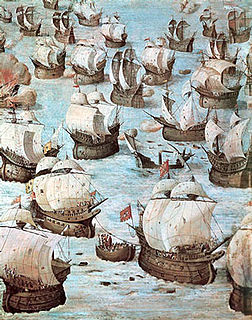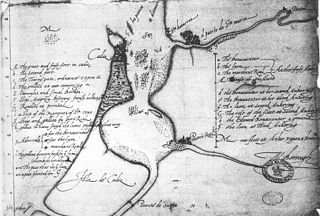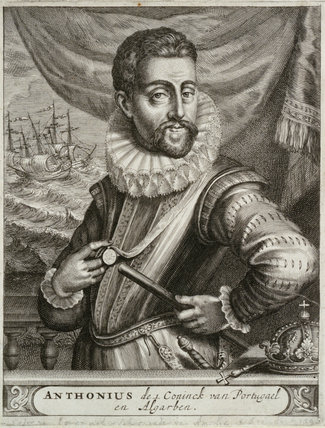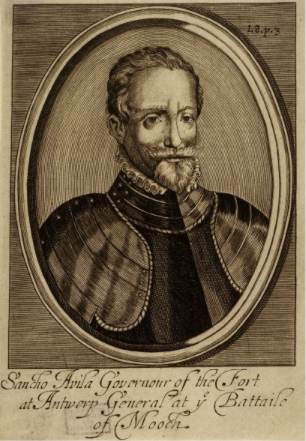
Fernando Álvarez de Toledo y Pimentel, 3rd Duke of Alba, GE, KOGF, GR, known as the Grand Duke of Alba in Spain and the Iron Duke in the Netherlands, was a Spanish noble, general, and diplomat. He was titled the 3rd Duke of Alba de Tormes, 4th Marquess of Coria, 3rd Count of Salvatierra de Tormes, 2nd Count of Piedrahita, 8th Lord of Valdecorneja, Grandee of Spain, and a Knight of the Order of the Golden Fleece. His motto in Latin was Deo patrum Nostrorum, which in English means "To the God of our fathers".

The House of Aviz known as the Joanine Dynasty was the second dynasty of the kings of Portugal. In 1385, the Interregnum of the 1383-1385 crisis ended when the Cortes of Coimbra proclaimed the Master of the monastic military Order of Aviz as King John I. John was the natural (illegitimate) son of King Peter I and Dona Teresa Lourenço, and so was half-brother to the last king of the Portuguese House of Burgundy or Afonsine Dynasty, Ferdinand I of Portugal. The House of Aviz continued to rule Portugal until Philip II of Spain inherited the Portuguese crown with the Portuguese succession crisis of 1580.

The Anglo-Spanish War (1585–1604) was an intermittent conflict between the kingdoms of Spain and England that was never formally declared. The war was punctuated by widely separated battles, and began with England's military expedition in 1585 to what was then the Spanish Netherlands under the command of the Earl of Leicester in support of the resistance of the States General to Spanish Habsburg rule.

The Portuguese succession crisis of 1580 came about as a result of the deaths of young King Sebastian I of Portugal in the Battle of Alcácer Quibir in 1578 and his successor and granduncle Henry I in 1580. As Sebastian and Henry had no immediate heirs, these events prompted a dynastic crisis, with internal and external battles between several pretenders to the Portuguese throne; in addition, because Sebastian's body was never found, several impostors emerged over the next several years claiming to be the young king, further confusing the situation. Ultimately, Philip II of Spain gained control of the country, uniting the Portuguese and Spanish Crowns in the Iberian Union, a personal union that would last for 60 years, during which time the Portuguese Empire declined.
This is a historical timeline of Portugal.

The English Armada, also known as the Counter Armada or the Drake-Norris Expedition, was a fleet of warships sent to Spain by Queen Elizabeth I of England in 1589, during the undeclared Anglo-Spanish War (1585–1604) and the Eighty Years' War. It was led by Sir Francis Drake as admiral and Sir John Norreys as general, and failed to drive home the advantage England had won upon the destruction of the Spanish Armada in the previous year. The Spanish victory marked a revival of Philip II's naval power through the next decade.

Pedro Henriquez d'Azevedo y Alvarez de Toledo, Count of Fuentes de Valdepero was a Spanish general and statesman.

Álvaro de Bazán, 1st Marquess of Santa Cruz de Mudela, GE, KOS, was a Spanish admiral. According to Spanish sources, he was never defeated, a remarkable achievement in a fifty-year long career. His personal galley, La Loba, thus called by her golden figurehead, was feared by Spanish enemies and regarded with hope amongst Spanish sailors and allies.

The naval Battle of Ponta Delgada, Battle of São Miguel or specifically the Battle of Vila Franca do Campo took place on 26 July 1582, off the coast of the island of São Miguel in the Portuguese archipelago of the Azores, during the War of the Portuguese Succession. A combined corsair expedition, mainly French, sailed against a Spanish naval force made up of Portuguese and Castilian ships, to preserve control of the Azores under pretender António, Prior of Crato and to defend the islands from incorporation into the Iberian Union—the largest French force sent overseas before the age of Louis XIV.
Francisco de Portugal, also known as Francis II of Portugal, 3rd Count of Vimioso, was the eldest son and heir of the 2nd Count of Vimioso, Afonso de Portugal.

Singeing the King of Spain's Beard is the derisive name given to the attack in April and May 1587 in the Bay of Cádiz, by the English privateer Francis Drake against the Spanish naval forces assembling at Cádiz. Much of the Spanish fleet was destroyed, and substantial supplies were destroyed or captured. There followed a series of raiding parties against several forts along the Portuguese coast. A Spanish treasure ship, returning from the Indies, was also captured. The damage caused by the English delayed Spanish plans to invade England by more than a year, yet did not dispel them.

The Battle of Salga occurred on 25 July 1581, along the Bay of Salga and around the coastal part of the parish of Vila de São Sebastião, island of Terceira in the Portuguese Azores, between Spanish and Portuguese forces. The latter, in the name of António, Prior of Crato, successfully defended the island against personal union with the Spanish crown, during the War of the Portuguese Succession.

The Battle of Cape St Vincent of 1641 took place on 4 November 1641 when a Spanish fleet commanded by Don Juan Alonso de Idiáquez y Robles intercepted a Dutch fleet led by Artus Gijsels during the Eighty Years' War. After a fierce battle two Dutch ships were lost but the Dutch claimed only a hundred of their men were killed; the Spanish fleet also lost two ships but over a thousand dead. The damaged Dutch fleet was forced to abandon its planned attack on the Spanish treasure fleet.

The Conquest of the Azores, but principally involving the conquest of the island of Terceira, occurred on 2 August 1583, in the Portuguese archipelago of the Azores, between forces loyal to the claimant D. António, Prior of Crato, supported by the French and English troops, and the Spanish and Portuguese forces loyal to King Philip II of Spain, commanded by the Admiral Don Álvaro de Bazán, Marquis of Santa Cruz, during the War of the Portuguese Succession. The victory of the Marquis of Santa Cruz resulted in the rapid Spanish conquest of the Azores, facilitating the integration of the Kingdom of Portugal and its colonial possessions into the Spanish Empire.

The Battle of the Gulf of Cádiz was a naval action which occurred on 7 August 1604, during the very last days of the Anglo-Spanish War (1585–1604). The battle took place when a flotilla of two galleons commanded by Antonio de Oquendo engaged two English privateers who were plundering shipping lanes and villages around the Gulf of Cádiz. One of the English ships was captured and the other damaged. Later in his life, Antonio de Oquendo led the Spanish fleet that was utterly defeated by the Dutch at the Battle of the Downs in 1639. Oquendo's action off Cádiz is notable for having been fought just 21 days before the signing of the Treaty of London, which ended the protracted war between England and Spain.

The Capture of Valkenburg of 1574, also known as the Capture of Valkenburg Castle, took place in early February 1574, at Valkenburg fortress, Limburg, Flanders, during the Eighty Years' War and the Anglo-Spanish War (1585–1604), in the context of the Siege of Leiden. The fortress of Valkenburg, garrisoned by five English companies commanded by Colonel Edward Chester, was of strategic importance to facilitate the Spanish efforts at Leiden. In early February, when the Spanish troops advanced over Valkenburg Castle, the English troops surrendered the fortress to the Spaniards and fled towards Leiden. Then, the Spanish forces entered and took possession of the fortress. For the cowardice demonstrated at Valkenburg, the English troops were rejected by the Dutch rebel army at Leiden, and finally Chester's troops surrendered to the Spanish army.
























